Western Digital Expands HGST Helium Drive Lineup with 10TB Ultrastar He10
by Ganesh T S on December 2, 2015 3:01 AM EST- Posted in
- Enterprise
- Storage
- HDDs
- Western Digital
- HGST
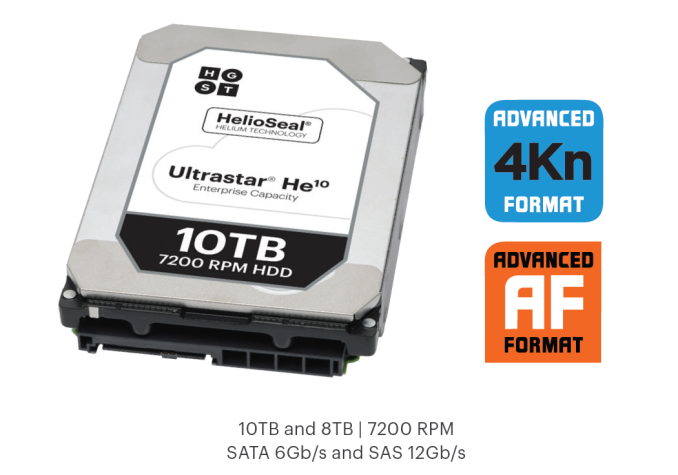
HGST, a Western Digital subsidiary, has been shipping hard drives sealed with helium for a couple of years now. Their helium drives have so far come in two flavors - the Ultrastar He drives using platters with traditional perpendicular magnetic recording (PMR) technology and the Ultrastar Archive Ha drives using platters with shingled magnetic recording (SMR). There are two main patented innovations behind the helium drives, HelioSeal and 7Stac. The former refers to placement of the platters in a hermetically sealed enclosure filled with helium instead of air. The latter refers to packaging of seven platters in the same 1" high form factor of traditional 3.5" drives.
The Ultrastar He6 6TB drive was introduced in November 2013, and this was followed by the He8 8TB drive late last year. In June 2015, the Ultrastar Ha10 SMR drive with HelioSeal technology was introduced. Around the same time, HGST also made it known that more than 1M HelioSeal units had been deployed. 1.33 TB platters have become available in air drives now, and HGST is taking advantage of that in the 10TB Ultrastar He10. The launch of the Ultrastar He10 PMR drive today also brings the news that more than 4M HelioSeal units have been deployed in various datacenters - pointing to the rapid rise in adoption rate of this technology.
We have already seen in our reviews that the helium drives offer the best performance to power ratio and watts per TB metric amongst all the drives in their capacity class. HGST also claim a 2.5M hour MTBF - much higher than traditional enterprise PMR drives. The initial cost of the helium drives have been substantially higher compared to the standard drives of the same capacity, but the TCO (total cost of ownership) metric is highly in favor of these drives - particularly for datacenter customers who need the drives to be active 24x7. HGST's press briefing included a slide that presented the potential TCO benefits that come about due to the increased capacity per rack, lower consumption per rack and lower power consumption per TB of the new He10 drives.
HGST indicated that the ramp in volume should help the initial cost to approach that of the air drives in the near future. For datacenter customers, that would mean an acceleration in obtaining the TCO benefits.
Coming to the core specifications, the Ultrastar He10 will come in both SATA 6Gbps and SAS 12Gbps varieties. The drives have 4KB sectors, though SKUs with 512-byte emulation are also available. Various data security options such as instant secure erase, self-encryption, secure erase and TCG encryption with FIPS are available.
The standard Ultrastar He drive features such as rotational vibration safeguard (for better RV tolerance in multi-drive servers) and the rebuild assist mode (for faster RAID rebuild) are retained. The drives come with a 256MB DRAM buffer.
Hard drives are struggling to reach the 10TB capacity point with traditional PMR technology. While Seagate did announce a few 8TB PMR drives earlier this quarter, it really looks like vendors need to move to some other technology (shingled magnetic recording or heat-assisted magnetic recording (HAMR)) in order to keep the $/TB metric competitive against the upcoming high-capacity SSDs. As of now, helium seems to be the only proven solution causing minimal performance impact and HGST appears to have a strong hold in this particular market segment.


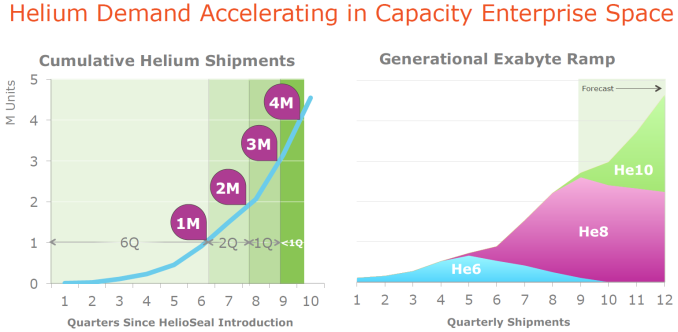
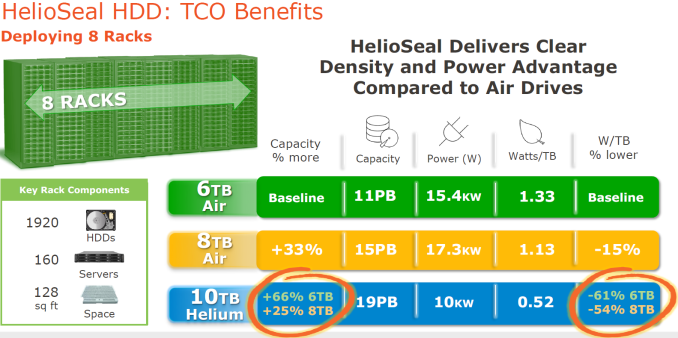
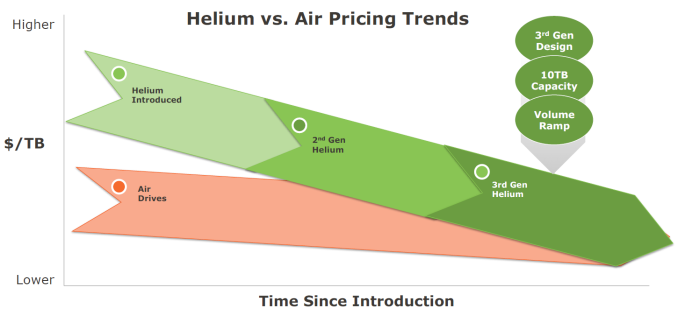
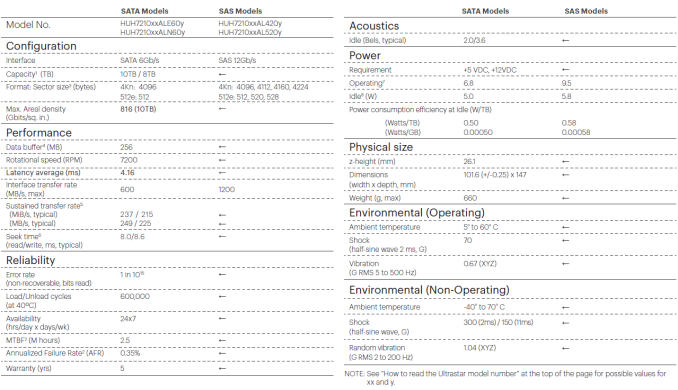
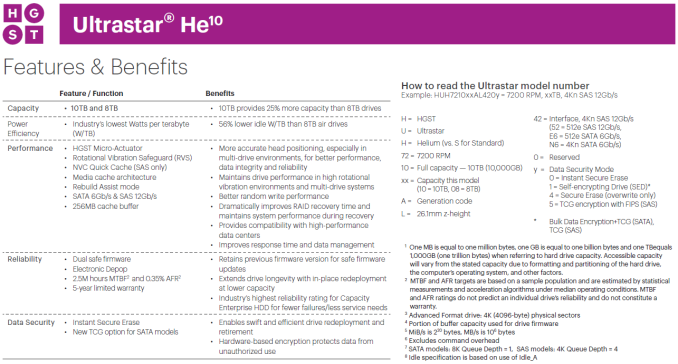








113 Comments
View All Comments
ddriver - Wednesday, December 2, 2015 - link
That's like saying sport cars are competing with cargo trucks. There is no competition between the two at this point. If the tech I want to see is produced - then yes, HDDs would actually be able to compete. But today those are entirely different market segments.RanDum72 - Thursday, December 10, 2015 - link
I have the feeling that ddriver is in love with the idea that harddrives should be 5.25 in size because it gives the impression of more 'value' and speed. I mean, 5.25 drive is bigger than a 3.5 drive, right? Well why doesn't somebody come up with a 5.25 sized drive that has like 15 SSD's inside, and has a built-in RAID10 controller inside interfacing externally with PCIe 16x?nils_ - Wednesday, December 2, 2015 - link
HGST is owned by WD which makes it practically 3.extide - Wednesday, December 2, 2015 - link
Don't forget SamsungWaltC - Wednesday, December 2, 2015 - link
@ddriver You cannot expect innovation and advance, especially of the type you'd like to see, in a market directed by top-down government regulation. Competition is what motivates R&D which in turn creates new products, etc. What companies strive for is actually to provide the very best value they can for a price the market will bear. If a company tries to give the least value it can it will probably fail quickly--that sort of thinking doesn't work in a competitive market. Don't know if you've noticed, but in the last 20 years technology has sky-rocketed in terms of capability while the prices for that technology have never been as low as they are today, and economies o scale have never been greater. The onus has changed from profit-per-unit to profits-per-thousand-units sold.BTW, I still remember my very own BigFoot...;) Slow as molasses and sort of noisy, IIRC, but I bought it for capacity and nothing else at the time. 5.25" is an interesting idea, no doubt. Where the mechanical drives have it all over SSDs is capacity, and my guess is that this trend will continue until SSD's develop to a point where the mechanicals can no longer offer substantially more capacity for substantially less money.
xthetenth - Wednesday, December 2, 2015 - link
Congratulations on fundamentally misunderstanding capitalism. Their priority isn't to sell as little value as possible, their priority is to maximize the disparity between perceived value and cost to manufacture. When possible this means adding things that increase value significantly (such as a hypothetical technology that increases performance and decreases total cost of ownership), but due to being based on some sort of development that has most of its cost to the manufacturer in a form independent of units produced, such as R&D or manufacturing changes so that with large production runs, the value increase is maintained but the cost decreases, driving that disparity upwards.Congrats on getting a serious pinko to defend capitalism by the way, it takes a serious level of wrong to do that.
bernstein - Wednesday, December 2, 2015 - link
problem is:- in the volume of one 3.5" HDD one can fit 4x 2.5" HDDs
- capacity remains roughly the same (4x2TB vs 1x8TB) - power use & cost however go up
- in a RAID these are way faster & more redundant than a single 3.5" drive (2-3 times the MB/s)
- random i/o is vastly improved (up to 4 times) - given a filesystem capable of caching the index on a SSD/RAM
- reliability is vastly improved (pseudo-/RAID)
the same things apply to 5.25" vs 3.5" HDDs...
hpglow - Wednesday, December 2, 2015 - link
They should just make them 10" so you can put your HDD next to your record player in your short bus. These guys are in the business to make money and they spend tons in R&D you think possibly they have done some research on these inanely obvious? I bet that they have and that they have and its some conspiracy and they have the prototypes in the corner next to the late 70's model car that got 50 mpg on tap water.beginner99 - Thursday, December 3, 2015 - link
Most 10'000 rpm drives are 2.5 inch...Large platter with high RPM doesn't work. On the other hand if you want speed, you should ignore HDDs anyway. Even if you have a 50TB HDD, it would magically get 10 times the speed. So it will take forever to fill or extract data from. HDDs are slowly dying off. It will probably take at least another if not 2 decades. first flash and then non-volatile RAM types will replace it completely.Next Gen Intel Processor (Kaby Lake 200-Series Chipset) will have support for Intel Optane SSD which use a non-volatile memory type. Eg. will make even high-end PCIe NVMe drives look like toys.
Mugur - Thursday, December 3, 2015 - link
And most 15k rpm drives are still 3.5... 😄